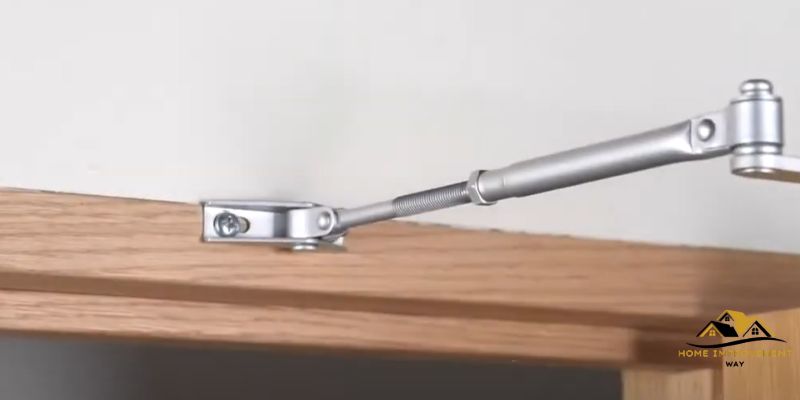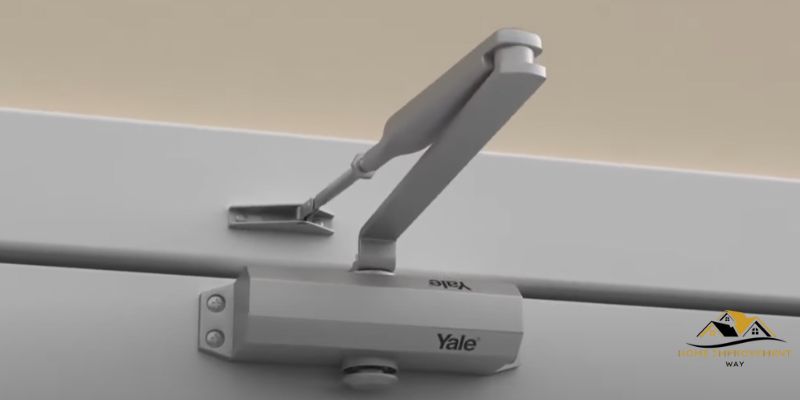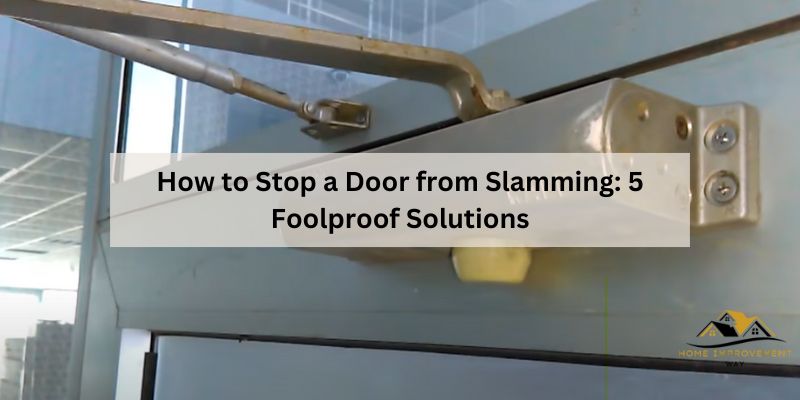To stop a door from slamming, place a rubber or adhesive-backed felt stopper on the door frame. Does the sound of a door slamming give you an unwanted jolt every time?
Don’t worry! There’s a simple solution to this problem. By placing a rubber or adhesive-backed felt stopper on the door frame, you can prevent the door from slamming shut forcefully. Not only will this help to preserve the peace and quiet in your home, but it will also prevent any potential damage to the door or door frame caused by the slamming action.
We will explore why doors slam and provide you with easy-to-follow steps to stop a door from slamming. No more startling noises or frustrations – let’s get started!
Understanding The Problem
Doors slamming shut in your home can be both annoying and potentially damaging. Not only can it startle you or others in the vicinity, but the force can also result in damage to the door or door frame. Understanding the causes behind door slamming is crucial in finding an effective solution. Additionally, recognizing the impact it can have on your surroundings will help you realize the importance of resolving this problem. In this section, we will delve into the causes behind door slamming as well as the potential consequences.

The Causes Of Door Slamming
The slamming of a door is often caused by external factors such as drafts, improper alignment, or uneven flooring. Understanding these causes will enable you to identify the root of the problem and find the appropriate solution. Let’s take a closer look at each cause:
- Drafts: One common cause of door slamming is the presence of drafts. These air currents can occur due to open windows, gaps around the door, or inadequate weatherstripping. When a draft hits the door, it can create enough force to close it abruptly.
- Improper alignment: Another cause of door slamming is improper alignment. A misaligned door can result from loose hinges, a warped frame, or an incorrectly installed door. These misalignments can prevent the door from closing smoothly and cause it to slam shut.
- Uneven flooring: Uneven flooring can also contribute to door slamming. When a door is installed on an uneven surface, it may not be able to stay in a partially open position. This causes it to forcefully swing shut, resulting in a loud slam.
The Impact Of Door Slamming
The consequences of door slamming can extend beyond the mere annoyance of a loud noise. Understanding the impact it can have will highlight the urgency of resolving this issue:
- Noise disturbance: Door slamming creates a disruption, which can be particularly bothersome in a quiet setting or when you’re trying to concentrate. It may also disturb others in your home, such as sleeping family members or roommates.
- Damage to the door and frame: Repeated slamming can cause damage to both the door and its frame. It can result in misalignment, cracks, splintering, or broken hinges. This damage not only compromises the door’s functionality but can also lead to costly repairs or replacements.
- Safety concerns: In certain situations, door slamming can pose safety risks. For example, if a door leading to an outdoor area slams shut due to a gust of wind, it could potentially trap someone outside or create a security concern by leaving the premises unsecured.
- Energy inefficiency: When doors slam shut due to drafts, it can lead to energy inefficiency. The air leakage caused by gaps or inadequate weatherstripping can result in increased energy consumption and higher utility bills.

Preventing Door Slamming
Doors slamming shut can be a pesky problem that not only creates an annoying noise but can also cause damage to the door and surrounding walls. Fortunately, there are several simple yet effective methods to prevent door slamming. In this blog post, we will explore three methods that can help you stop a door from slamming, namely adjusting door closers, installing door stoppers, and using door dampers.
1. Adjusting Door Closers
Adjusting the door closer is a quick and easy way to prevent door slamming. Door closers are mechanisms that control the speed and force with which a door closes. By adjusting the tension on the door closer, you can slow down the door’s closing speed, preventing it from slamming shut. Here’s how you can adjust a door closer:
- Identify the adjustment screw on the door closer. It is usually located on the top or side of the closer.
- Using a screwdriver, turn the adjustment screw clockwise to increase the tension and slow down the closing speed. Alternatively, turn it counterclockwise to decrease the tension and speed up the closing.
- Test the door to see if the slamming has been reduced. If needed, make further adjustments until the desired closing speed is achieved.
2. Installing Door Stoppers
Another effective way to prevent door slamming is by installing door stoppers. Door stoppers are simple devices that can be attached to the door or floor, preventing the door from closing abruptly. These stoppers act as a buffer and absorb the impact, eliminating the harsh slamming noise. Here’s how you can install a door stopper:
- Select a door stopper that suits your needs. There are various types available, such as wall-mounted stoppers, hinge pin stoppers, or floor-mounted stoppers.
- Position the stopper at a height where it can effectively prevent the door from slamming. This is usually around 1 to 2 inches from the floor.
- Attach the stopper to the door or floor as per the manufacturer’s instructions, using screws or adhesive.
- Test the door to ensure that the stopper successfully prevents slamming. Adjust the stopper’s position if necessary.
3. Using Door Dampers
Door dampers are devices that control the speed and force of a door’s closing motion, making them ideal for preventing slamming. These dampers are often installed inside the door frame or hinge and can significantly reduce the impact when the door closes. Here’s how you can use a door damper to stop door slamming:
- Determine the type of door damper suitable for your door. There are various options available, including spring-loaded dampers, hydraulic dampers, or pneumatic dampers.
- Install the door damper according to the manufacturer’s instructions. This may involve attaching it to the hinge, door frame, or door closer.
- Ensure that the damper is properly adjusted to control the door’s closing speed.
- Test the door to confirm that the damper effectively prevents slamming. Make adjustments if needed.
Other Solutions To Consider
If you’ve tried the basic methods to prevent your door from slamming shut but haven’t had much success, don’t give up just yet. There are a few other solutions you can consider to put an end to that annoying door slam. Let’s take a look at two more effective methods below:
4. Weatherstripping
One simple yet effective solution to stop a door from slamming is by using weatherstripping. Weatherstripping is a narrow strip of material, usually made from rubber or foam, that is used to create a seal around the edges of a door. By adding weatherstripping to your door, you can prevent it from slamming shut by cushioning the impact.
Here’s a step-by-step guide to applying weatherstripping:
- Clean the area around the door frame thoroughly to ensure proper adhesion.
- Measure the length of each side of the door frame and cut the weatherstripping material accordingly.
- Peel off the adhesive backing of the weatherstripping and carefully apply it to the door frame, pressing firmly to ensure a tight seal.
- Repeat the process for all sides of the door frame.
- Close the door gently to test if the weatherstripping has successfully prevented the door from slamming. If not, adjust the placement of the weatherstripping as needed.
Weatherstripping not only helps to stop door slamming but also provides insulation by preventing drafts and reducing energy loss, making it a practical solution for both noise and temperature control.
5. Changing The Hinge
If weatherstripping doesn’t do the trick, another option you can try is changing the hinge of the door. The hinge is the component that allows the door to swing open and closed. Sometimes, a faulty or worn-out hinge can cause a door to slam shut. By replacing the hinge, you can eliminate this issue and enjoy a quieter, more peaceful environment.
Here’s how you can change the hinge of your door:
- Start by removing the screws that hold the old hinge in place using a screwdriver.
- Carefully remove the old hinge and set it aside.
- Position the new hinge on the door and align it with the existing screw holes.
- Insert the screws into the holes and tighten them securely.
- Test the door to ensure that it opens and closes smoothly without slamming shut. If needed, make minor adjustments to the hinge alignment.
Changing the hinge not only helps to prevent door slamming but can also improve the overall functionality and lifespan of your door by ensuring proper alignment and smooth operation.
Conclusion
To put an end to the incessant door slamming, follow these practical tips. Adjust the hinge tension or install a door closer for controlled closing. Place rubber bumpers or adhesive felt pads on the frame to absorb the impact. Alternatively, install a door stopper or draft stopper to prevent forceful closures.
With these simple solutions, you can bid farewell to the annoying door slam and enjoy a peaceful home.


